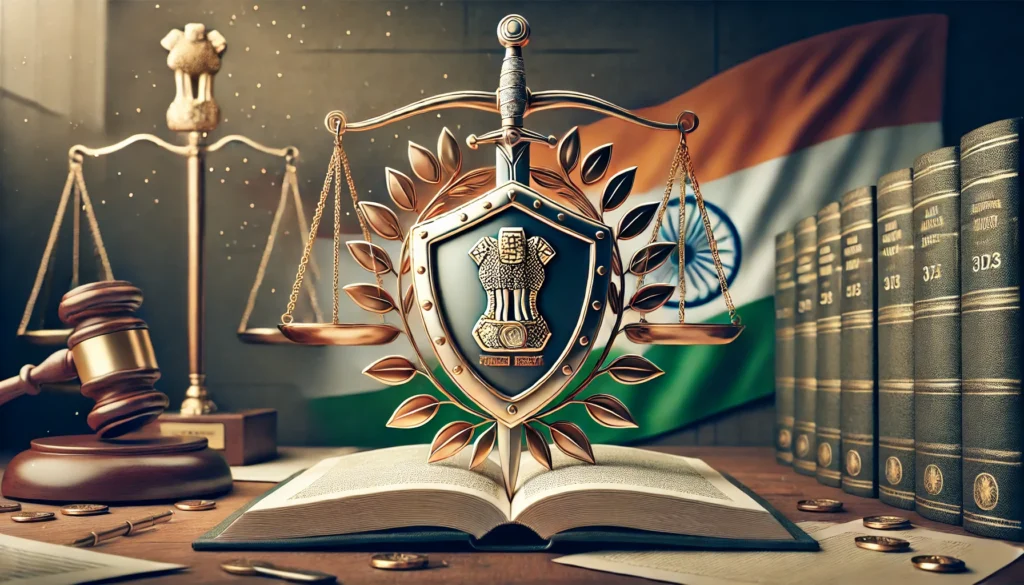Published On: 5th November, 2024
Authored By: Khushi Tiwari
S.S. Khanna Girls Degree college
ABSTRACT
Marriage law in India is governed by various personal laws based on religion, as well as the Special Marriage Act, 1954 for interfaith and civil marriages. For Hindus, Buddhists, Jains, and Sikhs, the Hindu Marriage Act, 1955 applies, while Muslims follow the Muslim Personal Law (Shariat) Application Act, 1937 Christians and Parsis are governed by the Indian Christian Marriage Act, 1872, and the Parsi Marriage and Divorce Act, 1936, respectively. The Special Marriage Act allows couples of different religions or those who wish to marry without religious customs to marry under a secular framework. These laws address conditions for marriage, divorce, maintenance, child custody, and alimony, reflecting a blend of religious traditions and modern legal principles of equality and justice.
INTRODUCTION
Marriage law in India encompasses a range of legal frameworks tailored to the country’s diverse religious communities. Each community follows its respective personal laws for marriage, such as the Hindu Marriage Act, 1955 Muslim Personal Law, and Indian Christian Marriage Act, 1872 among others. Additionally, the Special Marriage Act, of 1954 provides a secular option for interfaith or civil marriages. These laws regulate marriage, divorce, maintenance, and related matters, ensuring both religious customs and constitutional rights are respected while promoting fairness and equality in marital relationships.
Marriage is a Union between two individuals. It is a universal cultural institution that serves various functions including the formation of family the regulation of sexual relationships and the legal protection of offspring.
DEFINITION OF MARRIAGE ACCORDING TO SCHOLARS
Malinowski
“ Marriage as a contract for the production and maintenance of children “
Horton and Hunt
“ Marriage is the approved social pattern whereby two or more parson establish a family”
Marriage customs, rituals, and laws differ across cultures and religions, but it generally signifies commitment, partnership, and mutual responsibilities. In most societies, marriage is governed by legal frameworks to ensure the protection of spouses and children and to regulate property, inheritance, and other legal matters.
In modern times, marriage is increasingly recognized as a personal choice, emphasizing equality, consent, and mutual respect.
When it is absent in the institution of Marriage parties seek resolution of their dispute therefore that time there is a need for a particular law regarding the person in which community he belongs.
HINDU MARRIAGE
In Hinduism, marriage is considered a sacrament. The bond between the two is Marriage. Marriage is a Union between two individuals.
It is a universal cultural institution that serves various functions including the formation of family the regulation of sexual relationships and the legal protection of offspring.
DEFINITION OF MARRIAGE ACCORDING TO SCHOLARS
Malinowski
“ Marriage as a contract for the production and maintenance of children “
Horton and Hunt
“ Marriage is the approved social pattern whereby two or more parson establish a family”
Marriage customs, rituals, and laws differ across cultures and religions, but it generally signifies commitment, partnership, and mutual responsibilities. In most societies, marriage is governed by legal frameworks to ensure the protection of spouses and children and to regulate property, inheritance, and other legal matters.
In modern times, marriage is increasingly recognized as a personal choice, emphasizing equality, consent, and mutual respect.
When it is absent in the institution of Marriage parties seek resolution of their dispute therefore that time there is a need for a particular law regarding the person in which community he belongs.
As we know the concept of pativrata therefore there is the least chance that the parties want to separate from each other. But the modern era has given the conditions where parties are more frequent has reached conflict.
Hindu marriage conflicts are governed by the Hindu Marriage Act of 1955[1]
APPLICABLE ON: Hindu, Buddhist, Jains and Sikhs
KEY FEATURES
The Aim of Hindu Marriage; is Dharma, procreation, and pleasure.
Applies to: Hindus, Buddhists, Jains, and Sikhs. Key Features: Recognizes monogamous marriage. Defines conditions for a valid marriage (e.g., age, consent, not within prohibited relationships).Provides grounds for divorce such as cruelty, adultery, desertion, etc. Also allows for judicial separation, annulment, and maintenance.
CASE LAWS
Sarla Mudgal v. Union of India (1995)
Issue: Conversion to Islam for the purpose of contracting a second marriage.Facts: In this case, the petitioner challenged the practice of Hindu men converting to Islam solely to marry again without divorcing their first wife, thereby bypassing the monogamy requirement under the Hindu Marriage Act.
Judgment: The Supreme Court ruled that such conversions were not valid for contracting a second marriage without dissolving the first marriage. It held that conversion to Islam does not automatically dissolve a Hindu marriage, and a second marriage without divorce would amount to bigamy, which is punishable under the Indian Penal Code (Section 494).
Bhaurao Shankar Lokhande v. State of Maharashtra (1965)
Issue: Validity of a marriage without the performance of essential ceremonies.
Judgment: The Supreme Court held that the performance of essential ceremonies (like Saptapadi) is necessary for a valid Hindu marriage. A marriage without these ceremonies cannot be considered legally valid.
Shiv Kumar Yadav v. Usha Yadav (2005)
Facts: The husband filed for restitution of conjugal rights, seeking the court’s intervention to bring his wife back to the marital home. The wife refused, citing cruelty as the reason for her separation.
Judgment: The court ruled that the wife’s refusal to return to the marital home was justified due to the husband’s cruelty. It rejected the husband’s plea for restitution of conjugal rights, emphasizing that restitution cannot be ordered if one spouse faces cruelty or hardship.
Muslim Personal Law (Shariat) Application Act, 1937 Applies to Muslims.
Key Features: Follows Islamic law for marriage (Nikah), which includes concepts like Mahr (dower).
Allows polygamy (up to four wives) under certain conditions. Covers divorce through methods like Talaq, Khula, and Faskh. Following the 2019 law, Triple Talaq (instant divorce) was made illegal.
CASE LAWS
Shah Bano Case (Mohd. Ahmed Khan v. Shah Bano Begum, 1985)
Issue: Maintenance rights of a divorced Muslim woman.
Judgment: The court ruled that Talaq must follow due process, including prior notice to the wife and efforts at reconciliation. A unilateral Talaq pronounced arbitrarily without following these steps was held to be invalid.
Amina v. Hassan Koya (1985)
Issue: Right of Muslim women to Khula (divorce initiated by the wife).
Judgment: The court upheld the right of Muslim women to seek Khula without the consent of the husband, provided the wife returned the Mahr (dower) to the husband. The court dissolved the marriage on the ground that the wife was entitled to a divorce if she was willing to forgo the dower.
Shayara Bano v. Union of India (2017) – Triple Talaq Case.
Issue: Constitutionality of Talaq-e-Bidat (Judgment:
Supreme Court, in a landmark judgment, declared Talaq-e-Bidat unconstitutional and invalid. The court ruled that the practice violated the fundamental rights of Muslim women, including the right to equality (Article 14) and the right to life and personal liberty (Article 21).
Khatoon Nisa v. State of UP (2014)
Issue: Maintenance for divorced Muslim women under Section 125 of CrPC.
Judgment: The Allahabad High Court ruled that a divorced Muslim woman was entitled to maintenance under Section 125 of CrPC if she was unable to maintain herself, despite the provisions of the Muslim Women (Protection of Rights on Divorce) Act, 1986.
Indian Christian Marriage Act 1872 applies to Christians.
Key Features: Governs the solemnization of Christian marriages. Outlines provisions for marriages between Christians or interfaith marriages. Divorce under the Divorce Act, of 1869, is allowed on grounds such as adultery, cruelty, and desertion.
Special Marriage Act,1954
Applies to: All Indian citizens, irrespective of religion. Key Features: Facilitates civil marriages without the need for religious ceremonies. Enables inter-religious marriages.
Establishes a legal framework for registration of marriage, divorce, maintenance, etc. The Act allows couples to marry without renouncing their religion.
CASE LAWS
Anbalagan v. B. Devarajan (1984)
Issue: Caste status of children born under the Special Marriage
Judgment: The Supreme Court held that the Special Marriage Act does not alter the caste of a person or their progeny. A person belonging to a Scheduled Caste does not lose that status simply by marrying under the Special Marriage Act. Thus, the petitioner retained his Scheduled Caste.
Vijaya Lakshmi v. V.S. Raghunathan (1990)
Issue: Caste status of children born under the Special Marriage Act.
Judgment: The Supreme Court held that the Special Marriage Act does not alter the caste of a person or their progeny. A person belonging to a Scheduled Caste does not lose that status simply by marrying under the Special Marriage Act. Thus, the petitioner retained his Scheduled Caste status.
Lily Thomas v. Union of India (2000)
Issue: Bigamy and conversion for marriage.
In addition, there are many other personal laws across the country that depend upon the rituals, beliefs, and faith some other laws like the Indian Christian Marriage Act, 1987. Parsi Marriage and Divorce Act,1936, and so on.
Judgment: The Supreme Court ruled that conversion to another religion to contract a second marriage while already being married under the Special Marriage Act or Hindu Marriage Act would be considered bigamy and was punishable under the Indian Penal Code (Section 494). The court stated that the change of religion does not give the liberty to violate the legal obligations of the first marriage.
Constitutional Protections
Article 21 of the Indian Constitution guarantees the right to marry as a part of the right to life and personal liberty.
Lata Singh v. State of Uttar Pradesh (2006)
Issue: Inter-caste marriages and family opposition.
Facts: Lata Singh, an adult woman, married a man of her choice from a different caste. Her family opposed the marriage and filed a false case against her husband and his family. She petitioned the court for protection.
Judgment: The Supreme Court upheld her right to marry the person of her choice and ruled that any interference by family members or threats to the couple’s safety due to inter-caste marriage were illegal. The court directed the authorities to provide protection to the couple. Impact: This case reinforced that adults have the fundamental right to marry whomever they choose, regardless of caste or community, and that any obstruction by family or society violates their constitutional rights.
Article 14 guarantees equality before the law, and Article 15 prohibits discrimination based on religion, race, caste, sex, or place of birth.
There are various marriage laws in India that are governed by various religious and civil laws, depending on the faith or choice of individuals.
Conclusion
Marriage law in India is a complex interplay of religious customs, statutory laws, and judicial precedents. It governs the legal framework for marriages, divorce, alimony, child custody, and other related issues under various acts like the Hindu Marriage Act, 1955, Special Marriage Act, 1954, Muslim Personal Law, and others for different communities.
The marriage laws emphasize equality and protection of rights, particularly for women. Courts have played a pivotal role in addressing issues like child marriage, dowry, and gender equality within marriage. While personal laws differ based on religion, the Special Marriage Act provides a secular framework for those opting for civil marriages, offering a common platform that transcends religious barriers.
However, the call for a Uniform Civil Code (UCC) remains a subject of debate, as many argue that it would harmonize marriage laws while others believe it could infringe upon cultural and religious diversity. In conclusion, India’s marriage law continues to evolve to balance traditional practices with constitutional values of equality, non-discrimination, and individual rights.
Reference(s):
[1]Hindu Marriage Act, No. 25 of 1955, Indian Code (1956)
Muslim Personal Law (Shariat) Application Act, No. 26 of 1937, India Code (1937).
Indian Christian Marriage Act, No. 15 of 1872, India Code (1872).
Special Marriage Act, No. 43 of 1954, India Code (1954).



